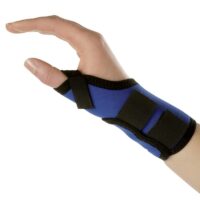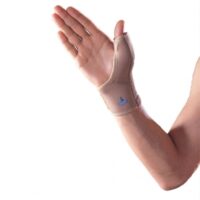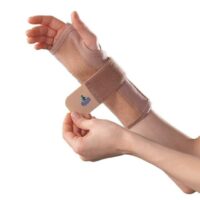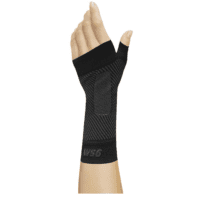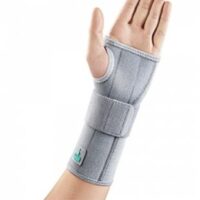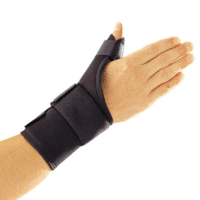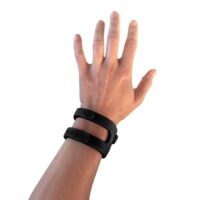Wrist Fracture
Article by John Miller


Wrist Fractures
Physiotherapy Guide to Wrist Fracture Recovery
Wrist fractures, often referred to as broken wrists, demand careful and informed management. The treatment approach varies depending on the fracture type and its stability. This guide offers insights from a physiotherapist’s perspective on managing wrist fractures effectively.
Understanding Different Types of Wrist Fractures
Wrist fractures come in various forms, including fractured radius, fractured ulna, Colles fracture, and carpal fractures like scaphoid fracture and lunate fractures. Each type requires a unique rehabilitation approach.

Managing Swelling and Pain Post-Fracture
It’s crucial to manage hand and finger swelling following a wrist fracture. Techniques such as keeping the hand elevated and regular movement, while ensuring the protection of the fracture, are vital. Being aware of complications like CRPS (Chronic Regional Pain Syndrome) is also important.
The Role of Physiotherapy in Wrist Fracture Recovery
Physiotherapy is instrumental in the recovery process. It involves exercises and the use of wrist supports, such as splints or casts. Adhering to the advice of your physiotherapist or surgeon is critical.
Enhanced Mobility and Function
Physiotherapy significantly improves mobility in the wrist joint post-fracture. Through a series of targeted exercises and manual therapies, patients can regain a range of motion, which is crucial for daily activities. This restoration of function is not just about moving the wrist but doing so without pain or stiffness.
Pain Management
One of the primary benefits of physiotherapy is effective pain management. Techniques like soft tissue massage, ultrasound therapy, and specific exercises can alleviate pain. Moreover, physiotherapists guide patients on pain management strategies that they can use at home, such as applying ice or heat.
Prevention of Long-term Complications
Physiotherapy aids in preventing long-term complications like joint stiffness, muscle weakness, or decreased function. By starting physiotherapy early in the recovery process, the risk of chronic issues is significantly reduced.
Customised Rehabilitation Programs
Each wrist fracture is unique, and physiotherapists understand this. They design customised rehabilitation programs tailored to the specific type and severity of the fracture. This personalisation ensures that the recovery process aligns with the individual’s lifestyle and physical demands.
Education and Support
Physiotherapists provide invaluable education about wrist health and injury prevention. They empower patients with knowledge about their condition and the recovery process. This support extends beyond physical treatment, offering psychological benefits as patients feel more in control and informed about their healing journey.
Improved Strength and Stability
Strengthening exercises are a cornerstone of physiotherapy. These exercises are designed to rebuild strength in the wrist and surrounding muscles, which is crucial for stability and injury prevention in the future.
Enhanced Quality of Life
Ultimately, the goal of physiotherapy is to enhance the patient’s quality of life. By restoring function, managing pain, and preventing further complications, patients can return to their normal activities and enjoy a more active, fulfilling lifestyle. This holistic approach to recovery is what sets physiotherapy apart as a vital component of treating wrist fractures.
Exercises for Wrist Fracture Rehabilitation
Exercise regimens should be tailored to the specific type of wrist fracture. Performing exercises frequently in short sessions is more beneficial than fewer long sessions.
When to Seek Professional Advice
If symptoms like increased swelling, pain, or sensations such as pins and needles occur, contacting your physiotherapist or doctor immediately is crucial. This is especially important after a traumatic fall.
Conclusion
Wrist fractures are complex injuries that require specialised care. Following the guidance of healthcare professionals ensures a safer and more effective recovery.
What to Do?
For personalised advice and treatment plans, consulting with a physiotherapist is recommended. Visit PhysioWorks for more information and resources.
Rochedale - Call 38410277
Book Online: RochedaleSalisbury - Call 32751044
Book Online: SalisburySandgate - Call 32691122
Book Online: SandgateRelated Articles
- Post-Fracture Physiotherapy: Explores the importance of tailored physiotherapy programs post-fracture, highlighting exercises and strategies for a balanced recovery.
- Effective Hand & Wrist Pain Treatment With Physiotherapy: Offers comprehensive treatment options for hand and wrist pain, including ergonomics and physiotherapy modalities like joint mobilisation and muscle treatment.
- Carpal Tunnel Syndrome: Effective Treatments: Discusses physiotherapy treatments for Carpal Tunnel Syndrome, a condition that can affect wrist health, focusing on mobility exercises and pain relief methods.
- Repetitive Strain Injury (RSI): Discussing and managing RSI, which could be helpful for preventing conditions related to wrist fractures.
- Common Causes of Wrist & Hand Pain: Let’s talk about your hand and wrist.
- de Quervain’s Tenosynovitis: Causes, physiotherapy and care.
- Wrist Tendinopathy: An article about this common forearm problem and how to fix it.
Article by John Miller
Common Wrist & Hand Pain or Injuries


Wrist and hand pain can significantly impact daily life, limiting your ability to perform simple tasks. In this article, we explore the common causes of wrist and hand pain, various injuries, and effective treatment options from a physiotherapist's perspective.
Traumatic Injuries
Traumatic injuries such as broken wrists, finger sprains, and thumb sprains are common causes of wrist and hand pain. These injuries often result from falls, accidents, or direct impacts. They cause immediate pain, swelling, and difficulty in moving the affected area.
Overuse Injuries
Overuse injuries occur due to repetitive motions or prolonged strain on the wrist and hand. Common overuse injuries include carpal tunnel syndrome, de Quervain’s tenosynovitis, and repetitive strain injury (RSI). These conditions often result in pain, numbness, and tingling sensations.
- Carpal Tunnel Syndrome
- de Quervain's Tenosynovitis
- Muscle Strain
- Overuse Injuries
- RSI - Repetitive Strain Injury
- Wrist Tendinopathy
Degenerative or Systemic Conditions
Conditions such as arthritis and rheumatoid arthritis can cause chronic wrist and hand pain. These conditions are typically progressive, leading to persistent pain, stiffness, and swelling in the joints.
Treatment Options for Wrist & Hand Pain
Physiotherapy offers a range of effective treatments for managing wrist and hand pain. Here are some common treatment approaches:
- General Management and Early Injury Treatment
Early intervention is crucial for managing wrist and hand injuries. Avoiding harmful activities, applying ice, and resting the affected area can prevent further damage. - Ergonomics
Proper ergonomics can reduce the risk of overuse injuries. An online workstation assessment can help identify and correct poor ergonomic practices that contribute to wrist and hand pain. - Joint Mobilisation Techniques
Physiotherapists use joint mobilisation techniques to improve joint movement and reduce pain. Physiotherapy instrument mobilisation (PIM) is a specialised technique that can effectively target stiff joints. - Muscle Treatment
Soft tissue massage and strength exercises can alleviate muscle tension and improve function. These treatments help restore normal movement patterns and reduce pain. - Support & Protection
Wrist braces, supportive taping, and kinesiology tape can provide stability to injured areas, preventing further strain and promoting healing. - Pain Relief Approaches
Acupuncture, dry needling, electrotherapy, and local modalities like heat packs and TENS machines can offer significant pain relief. These methods help manage pain and promote recovery.
Conclusion
Wrist and hand pain can stem from various causes, including traumatic injuries, overuse, and degenerative conditions. Effective management through physiotherapy can significantly improve your quality of life. Remember, early intervention and proper treatment are crucial in preventing long-term issues.
What to Do?
If you experience wrist and hand pain, seek the professional advice of your physiotherapist. They can provide a personalised treatment plan to address your specific needs and help you return to your daily activities pain-free.
Rochedale - Call 38410277
Book Online: RochedaleSalisbury - Call 32751044
Book Online: SalisburySandgate - Call 32691122
Book Online: SandgateWrist & Hand Pain FAQs
- What are the common causes of wrist and hand pain? Wrist and hand pain can result from traumatic injuries, overuse conditions, and degenerative diseases like arthritis.
- How can carpal tunnel syndrome be treated? Carpal tunnel syndrome can be managed with physiotherapy, ergonomic adjustments, wrist braces, and sometimes surgical intervention.
- What are the symptoms of de Quervain’s tenosynovitis? Symptoms include pain and swelling near the base of the thumb, difficulty gripping, and a catching or snapping sensation when moving the thumb.
- How does physiotherapy help with wrist and hand pain? Physiotherapy offers treatments like joint mobilisation, muscle strengthening, and pain relief techniques to improve function and reduce pain.
- When should I see a physiotherapist for wrist and hand pain? If you experience persistent pain, swelling, or difficulty in movement, it is advisable to consult a physiotherapist for a proper assessment and treatment plan.
- Can ergonomic changes reduce wrist and hand pain? Yes, proper ergonomic practices can significantly reduce the risk of developing overuse injuries and alleviate existing pain.
Related Articles
- Ergonomics and Your Workstation
Discover how proper ergonomics can prevent wrist and hand pain. - Managing Carpal Tunnel Syndrome
Learn about effective treatments for carpal tunnel syndrome. - Understanding de Quervain’s Tenosynovitis
Find out the causes and treatments for de Quervain’s tenosynovitis. - Physiotherapy for Arthritis
Explore how physiotherapy can help manage arthritis pain. - Effective Use of Wrist Braces
Understand the benefits of wrist braces for support and pain relief. - The Role of Strength Exercises in Pain Management
Discover how strength exercises can alleviate wrist and hand pain. - Benefits of Acupuncture and Dry Needling
Learn how acupuncture and dry needling can provide pain relief. - Electrotherapy for Pain Management
Find out how electrotherapy can help manage wrist and hand pain. - Understanding Repetitive Strain Injury (RSI)
Get insights into the causes and treatments for RSI. - Joint Mobilisation Techniques in Physiotherapy
Learn about various joint mobilisation techniques used in physiotherapy.
Common Wrist & Hand Pain Treatments
General Management
- Early Injury Treatment
- Avoid the HARM Factors
- What to do after a Muscle Strain or Ligament Sprain?
- Sub-Acute Soft Tissue Injury Treatment
- Ergonomics
- Online Workstation Assessment









